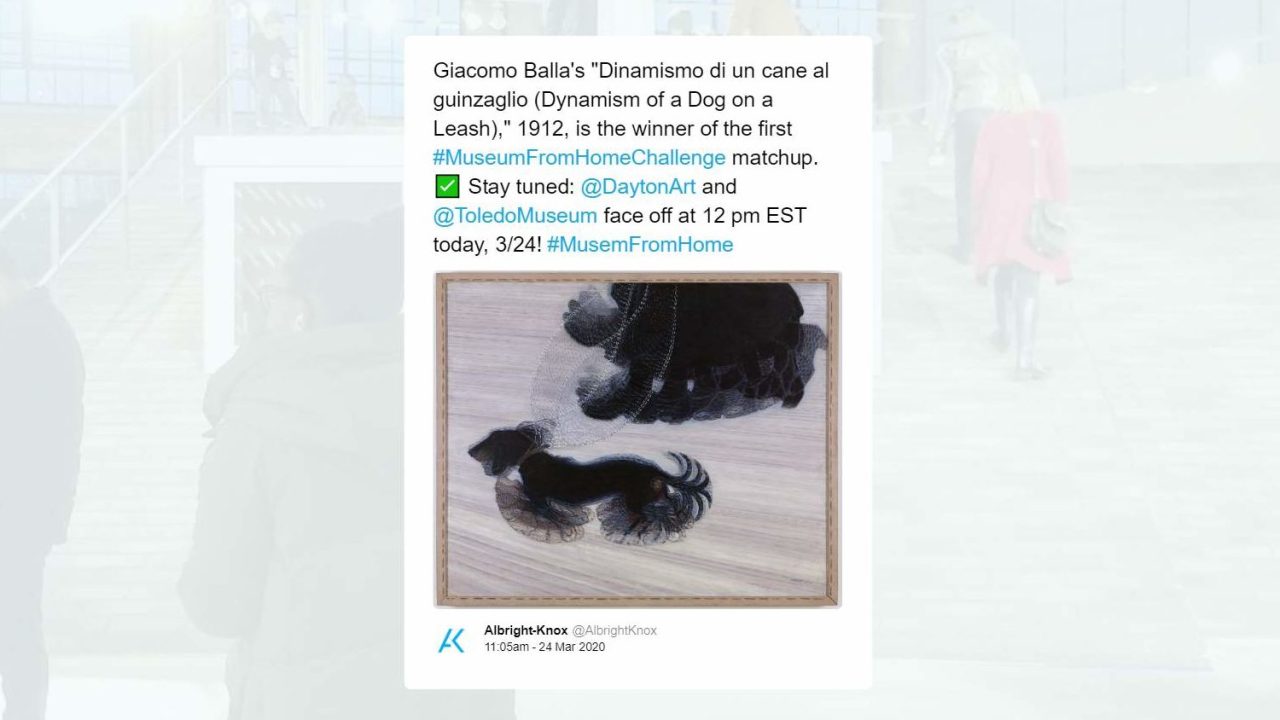
Ever since the rash of closures in response to the COVID-19 pandemic, museums have been working behind the scenes to set strategies for engaging the public through remote alternatives. Within days, two hashtags emerged on social media platforms: #MuseumFromHome and #MuseumMomentOfZen—which speak to the need for education, stimulation, and inspiration during our challenging and confusing times. This week, the Albright-Knox Art Gallery in Buffalo debuted its strategy: an online showdown of artworks museums submit from their collections. Every twenty-four hours, the museum is matching up two works submitted through this link (submissions are still open!) and letting its followers vote on the winner, to provide fun points of entry for conversations on aesthetics and art history.
We asked the Albright-Knox Art Gallery’s Associate Editor, Stephen Boyd, to explain this strategy and the considerations that went into it. Keep your eye on the Alliance Blog for more on these emerging strategies in the coming weeks, and contact us if you have something to share with the field as it plans its response.
More #MuseumFromHome strategies:
- The National Gallery of Art’s social media gallery tours
- The Akron Art Museum’s collaborative crosswords
- The Carnegie Museum of Natural History’s funny TikToks
First of all, give us on the rundown on your #MuseumFromHome art challenge. What is it?
The #MuseumFromHomeChallenge is inspired by the #ArtMadness social media campaign we started in 2014, based on the NCAA’s March Madness Tournament. The campaign centered on head-to-head matchups between artworks. People were encouraged to vote for their favorite work, sending it on to the next “round” until a winner emerged. The #MuseumFromHomeChallenge is a bit different in that it doesn’t involve brackets or rounds—instead, we’re doing single head-to-head matchups for 24 hours so museums can compete and have fun.
Pick your favorite artwork in the first #MuseumFromHome Challenge poll! The poll starts at 12 pm EST and ends 3/24 at 11 am EST. #MuseumFromHomeChallenge
— Albright-Knox (@AlbrightKnox) March 23, 2020
How did you come up with the idea for it?
We started #ArtMadness because we saw people getting excited about March Madness games, and wondered how we could bring that excitement into the museum world on social media. Now, with museums closed and sports postponed, and in a situation where every museum is pushing out huge amounts of content across social channels, we saw an opportunity to bring that excitement back and give our colleagues a reason to get competitive and creative.
Why are you asking other institutions to participate, instead of just using your own collection?
The inaugural #ArtMadness campaign used only works from the Albright-Knox’s collection, and we saw unprecedented excitement and engagement. The following years, we wanted to make the campaign even bigger, so we put out an open call to museums to join in and were thrilled with the response. Instead of us just talking about ourselves, we were able to engage each year with 15 different museums across the U.S. and Canada with fun elements of rivalry and competition. With the #MuseumFromHomeChallenge, we wanted to inspire people to promote their “home” museums in the same way they would their favorite teams. Things are changing so quickly that we thought it’d be helpful for our fellow museums to have a competitive framework to talk about their artworks and collections.
WOW! What a nail-biter in the #MuseumFromHomeChallenge. @ToledoMuseum‘s work by Albert Bierstadt squeaked out the win with 52% of the vote. Thanks to @ToledoMuseum and @DaytonArt for an electrifying competition. @MAG_Rochester and @RockwellMuseum face off at 12 pm EST! pic.twitter.com/hlQLpM3D5T
— Albright-Knox (@AlbrightKnox) March 25, 2020
Do you have any plans to foster discussions about the artworks in contention? How do you hope participating might drive engagement with the work in general?
We always share information about the works and artists that are featured. That way, people can learn about the works before making their selections, and hopefully discover new artists and works they’ve never seen before. The idea is that people can make their choices based on aesthetics, “I like this work because it’s prettier than that one,” or based on art-historical background, or on the artists involved, or any other criteria they choose. This way, there are multiple entry points to engage in the competition and all of them are valid.
She appears as the title character—the Aztec god of summer, flowers, pleasure, love, dancing, painting, creativity & the soul. Plus, the print features a hand-painted frame by the artist—COOL! [“Xochipilli ‘The Flower Prince,” 2018] @RockwellMuseum #MuseumFromHomeChallenge 2/2 pic.twitter.com/7s8SZvT8k9
— Albright-Knox (@AlbrightKnox) March 25, 2020
Do you have any other unique #MuseumFromHome strategies in mind? Maybe even ones that are far-fetched at this point?
Like every other museum and non-profit, we’re working quickly to adjust to these new circumstances so we can continue to engage our communities and provide resources to inspire creativity. Our Education Department has developed at-home art activities and lesson plans for families; we’re discussing video activities and lessons; and we’re trying to use social in ways that are conversational, like trivia, personal stories about artworks, and #AskACurator days.
What advice would you give to other museums planning their own strategies?
Pursue every idea that you have the bandwidth to pursue, even if it seems crazy. This is a good time for experimentation and innovation (by necessity). Nothing has to be perfect! We’re all in this together, and museums continue to be great sources of comfort and inspiration because of the amazing people who work in them.








